Connecticut Rare Disease Day at the Capitol
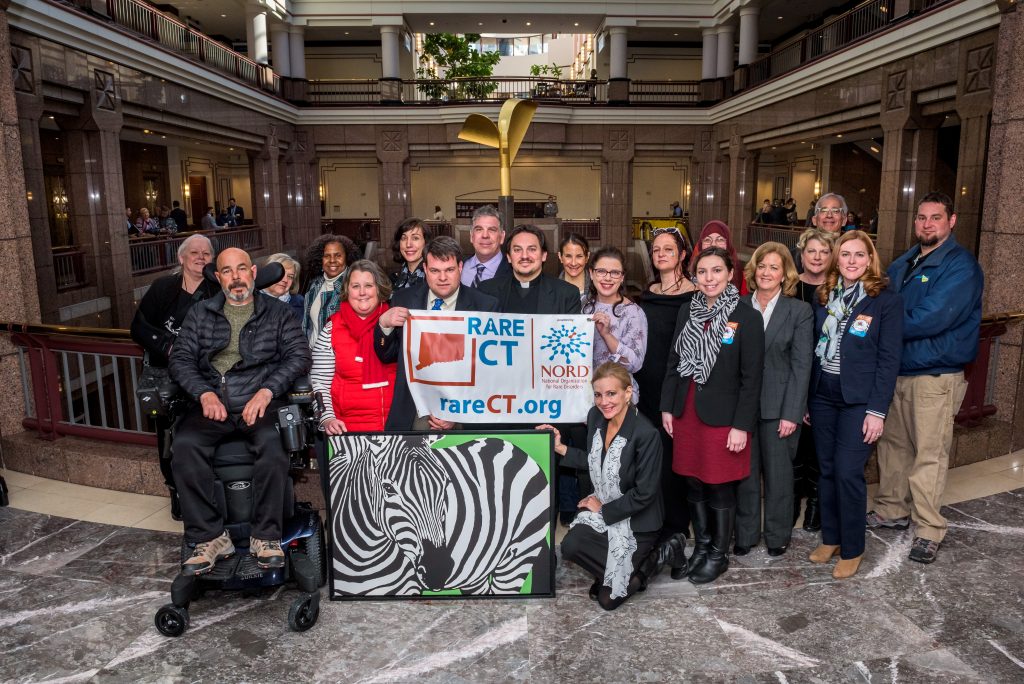
Sixth-grader Daniela Delgado told Connecticut lawmakers on Rare Disease Day that she lives with rare disease just like 30 million other people in the United States – and just like them – she matters.
“We are not a burden. We are human beings just like everybody else,” Daniela told about 130 people gathered at the Capitol in Hartford for Rare Disease Day. The day is celebrated nationally and globally on the last day of February each year. (Click here for state-by-state information.)
Daniela was diagnosed with not one, but two, rare diseases: von Willebrand Disease, a rare, lifelong bleeding disorder; and Ehlers Danlos Syndrome, a group of disorders affecting connective tissue supporting the skin, bones, blood vessels and many other organs and tissues.
She needs expensive drugs to treat her disease and ease her symptoms; without them, the cost would be exponentially more for hospitalizations.
“These are real treatments, and they keep us alive,” she said. “We need this medication to live.”
Daniela is a patient advocate from Sandy Hook, CT, who at age 4, with the help of her parents, created Daniela’s Little Wish, bringing joy to kids facing serious illnesses by baking and delivering one-of-a-kind birthday cakes.
She joined about two dozen speakers at a legislative informational session that included legislators, patients, doctors, researchers, nurses, caregivers, advocates, business people and a representative of Sofia Sees Hope.
7,000 Rare Diseases in the US
Rare disease is more common than most people realize.
Leber congenital amaurosis (LCA) and other inherited retinal diseases (IRDs) are among the approximately 7,000 rare diseases. These include more than 500 types of rare cancers and all pediatric cancers.
A rare disease is defined as any disease, disorder, illness or condition affecting fewer than 200,000 people in the United States. An estimated 25-30 million Americans, almost 1 in 10, have rare diseases. In Connecticut, an estimated 300,000 people have rare diseases.
Connecticut may be the Insurance Capital of the World, but the Nutmeg State gets an F when it comes to individual insurance protections, according to Connecticut’s rare disease report card prepared by the National Organization for Rare Disorders and NORD’s Rare Action Network (RAN), the hosts of Connecticut’s Rare Disease Day.
The state requires some insurers to offer guaranteed plans to a limited number of people. It does not have an individual mandate and has not enacted a reinsurance waiver to keep insurance affordable for people with pre-existing conditions. Connecticut had minimal limits on issuing short-term, limited-duration health plans or association health plans.
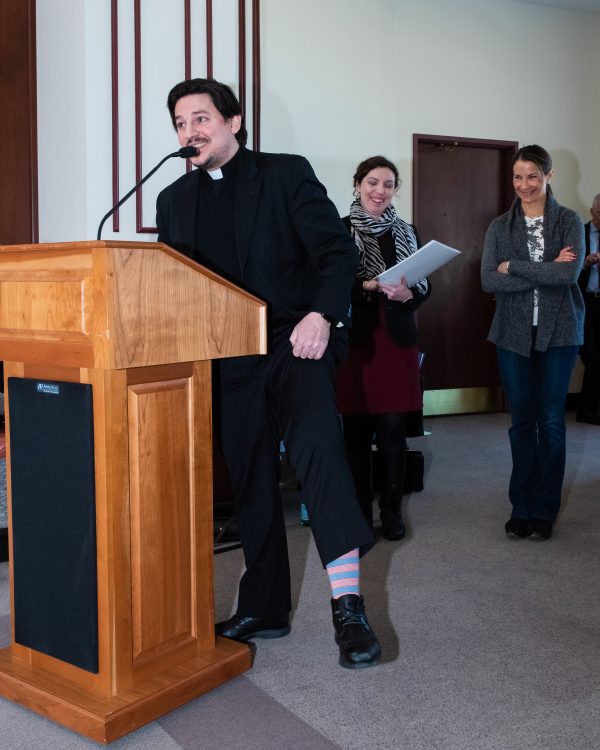
Father Nikolas Karloutsos
State Rep. Joe Aresimowicz, Democratic House Speaker, and State Sen. Len Fasano, Republican Senate Minority Leader, have introduced several pieces of legislation addressing medical education in screening for rare cancers and assistance for patients and families with developmental disabilities. Fasano also helped the state become one of the first to add Adrenoleukodystrophy (ALD) to Connecticut’s Newborn Screening (NBS) panel.
Aresimowicz said the focus of the event was not on politics or political parties.
“We are here because we want to make Connecticut a better place.”
Fasano told the gathering: “This is a civil rights issue to get the proper medications and research to go forward.”
Greta Stifel, who has two rare diseases on top of cancer, detailed her grueling journey of misdiagnoses and many surgeries. In 2016, she established the Stifle Cancer Foundation to bring awareness to a type of cancer comprised of Neuroendocrine Tumors (NETS).
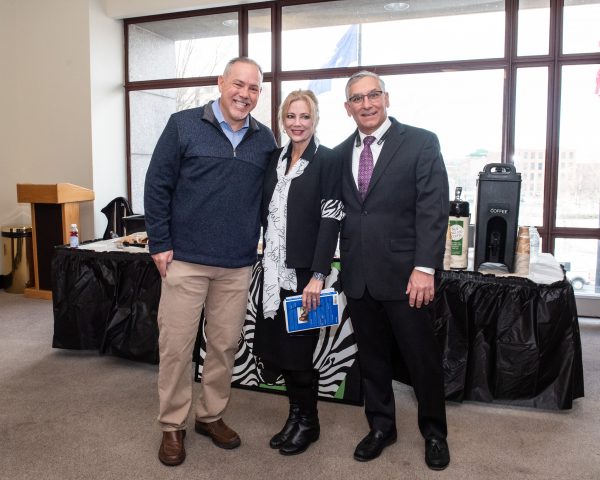 “We are the ‘Rare Rebels’,” she said. “We are the ‘Rare Revolution’.”
“We are the ‘Rare Rebels’,” she said. “We are the ‘Rare Revolution’.”
She is a constituent of Aresimowicz, and the proposal behind the pending legislation of House Bill 6522 comes from her. The bill’s title is: An act concerning continuing medical education in screening for inflammatory breast cancer and gastrointestinal cancers.
Stifle said the legislation is a step in the right direction, but the state needs to do much more with rare disease awareness, education, funding and research. “
Connecticut actually should be the Silicon Valley of Rare Disease,” she said.
State Rep. Jonathan Steinberg, chairman of the General Assembly’s Public Health Committee, said having one day to recognize rare diseases is not enough.
“It needs to be Rare Disease Day every day in the state of Connecticut.”
Steinberg, along with RAN’s Volunteer State Ambassador Lesley Bennett, said the legislature needs to form a Rare Disease Advisory Council to find treatments, fund research and advocate for Connecticut’s constituency living with rare disease.
“A lot of our patients have problems getting access to services because people don’t understand the disorders,” Bennett said.
The advisory council would be comprised of patients, patient advocates, doctors, researchers, business leaders and community members to address the emerging public health priority of rare diseases, including LCA and other IRDs.
Erica Mumm, a Clinical Assistant Professor at the Quinnipiac School of Nursing and mother of a son with a rare genetic disorder, said the system needs to change. She also supports the creation of a rare disease advisory council.
Not a one-size-fits-all community
“We are rare, so we don’t fit into a one-size-fits-all system,” Mumm said.
Her son, who turns 3 this month, has a rare genetic disorder called KCNQ2 encephalopathy, a type of epilepsy that becomes apparent in the first three months of life and is characterized by frequent and difficult-to-treat body seizures.
Mumm advocated for care coordination and described the drain and debilitation she feels as a caregiver. She also advocated for a palliative care network to improve emotional support for caregivers. She has exhausted her savings and said as her voice cracked through tears that her home needs extensive renovations to accommodate her son.
She also implored lawmakers to do away with resetting the clocks twice a year with Daylight Savings Time.
“For us, it’s a change of medication routine,” she said. To keep her son on track with his medications, three weeks before changing the clocks, she must begin making incremental changes in dosages.
A family panel of four caregivers told the group Connecticut needs to support businesses researching and developing treatments for rare diseases.
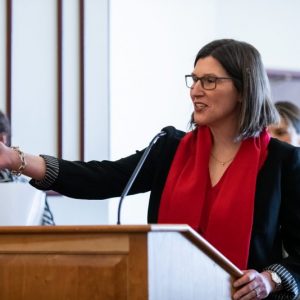
Alissa Dejonge
“The sky’s the limit because of research,” Alissa DeJonge said. She is Vice President of Research for the Connecticut Economic Resource Center, Inc., and the mother of a 2½-year-old son with severe hemophilia.
Heather Knapp, a panelist and mother of three, described the benefits of the state-mandated NBS program that in 1964 began statewide blood-spot screening for Phenylketonuria (PKU), the same rare disease doctors identified in her son at birth. Early detection and treatments can mean the difference between lifelong impairment and healthy development. Knapp praised NORD for helping her with resources, saying she finally found peace of mind when she connected with the organization.
Panelist Father Nikolas Karloutsos, a Greek Orthodox priest, detailed the difficulties in getting a diagnosis for his daughter, who has a BRAF mutation RASopathy, which probably is Cardiofaciocutaneous (CFC) Syndrome. The very rare disorder particularly affects the heart (cardio-), facial features (facio-) and the skin and hair (cutaneous); it causes moderate to severe delayed development and intellectual disability.
For Jennifer Ianuzzi, it took 20 months until doctors diagnosed her daughter with Smith-Magenis Syndrome, a developmental disorder caused by chromosome 17 microdeletions. She appealed to the group for support for respite from 24/7 caregiving.
Researchers, scientists and professors also presented updates in their fields.
Ching Lau, MD, Ph.D., the Division Head of Connecticut Children’s Medical Center’s (CCMC) Center for Cancer & Blood Disorders and Professor of Genomic Medicine at JAX Laboratory, said that developing and strengthening international genetic research collaborations will help people around the globe access rare disease information through genetic registries. Dr. Lau specializes in finding treatments for children with rare blood, bone and brain cancers.
“We will conquer these diseases at the end,” he said.
Dr. Charles Whitaker, a neuromuscular neurologist at the Hospital for Special Care (HFSC), specializes in adult neuromuscular disorders, such as Amyotrophic Lateral Sclerosis (ALS) and muscular dystrophy. Dr. Whitaker said patients, physicians and experts need to work together to evaluate changes at a policy level that address the special needs of the rare disease population, which, along with having pre-existing conditions, in many instances are highly debilitated. As a clinical researcher working on treatments and cures, he said: “We would love to be part of that cure.”
Gyula Acsadi, MD, Ph.D., said interventions never possible in rare diseases are changing the lives of young children because researchers are focused on discovering genetics and the biology of disease.
“This last five, six years were amazing with how research succeeded,” he said.
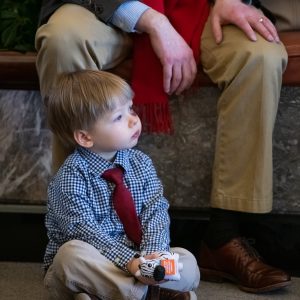
Alissa Dejonge’s son listens as she speaks at the podium.
Dr. Acsadi, Division Head of Neurology at CCMC and Professor of Pediatrics and Neurology at UConn School of Medicine, works with children living with Spinal Muscular Atrophy (SMA), the leading cause of death of infants and toddlers of any genetic disorder. SMA robs children of physical strength.
Newly approved NBS for SMA and new treatments administered early in children show remarkable results, he said. Even so, ongoing fights continue with insurance companies unwilling, for example, to pay $15,000 for a treatment that will save $2 million in care. One young patient spent more than 300 days in the hospital before receiving treatment, followed by zero days in the hospital.
“It’s an easy win in terms financially,” Dr. Acsadi said.
Dr. Saquib Lakhani, Clinical Director of Yale Medicine’s Pediatric Genomics Discovery Program, said 30 percent of children in the Intensive Care Unit have rare diseases and very complex needs.
“It’s a collective mistake to ignore rare diseases,” he said. “They have to be addressed.”
Dr. Lakhani specializes in caring for newborns and infants with undiagnosed birth disorders. Using DNA sequencing allows for many more diagnoses, he said.
“It’s been a remarkable change.”
He described a whole exome sequencing test that relies on new technology and allows rapid sequencing of large amounts of DNA with the potential to discover hundreds and hundreds of diseases.
While patients could benefit from this amazing vehicle to find the source of a disorder, they have difficulty getting insurance coverage.
“We don’t know what we’re looking for. (The DNA sequencing) can actually give you the diagnosis that you didn’t have before.”
Moving forward with research and developing treatments for rare disease requires that critical diagnosis.
As Daniela – our young cake-baker extraordinaire living with two rare diseases – summed up in her address to the legislative group:
“We are 30 million and counting. We are alive and we deserve better.”
